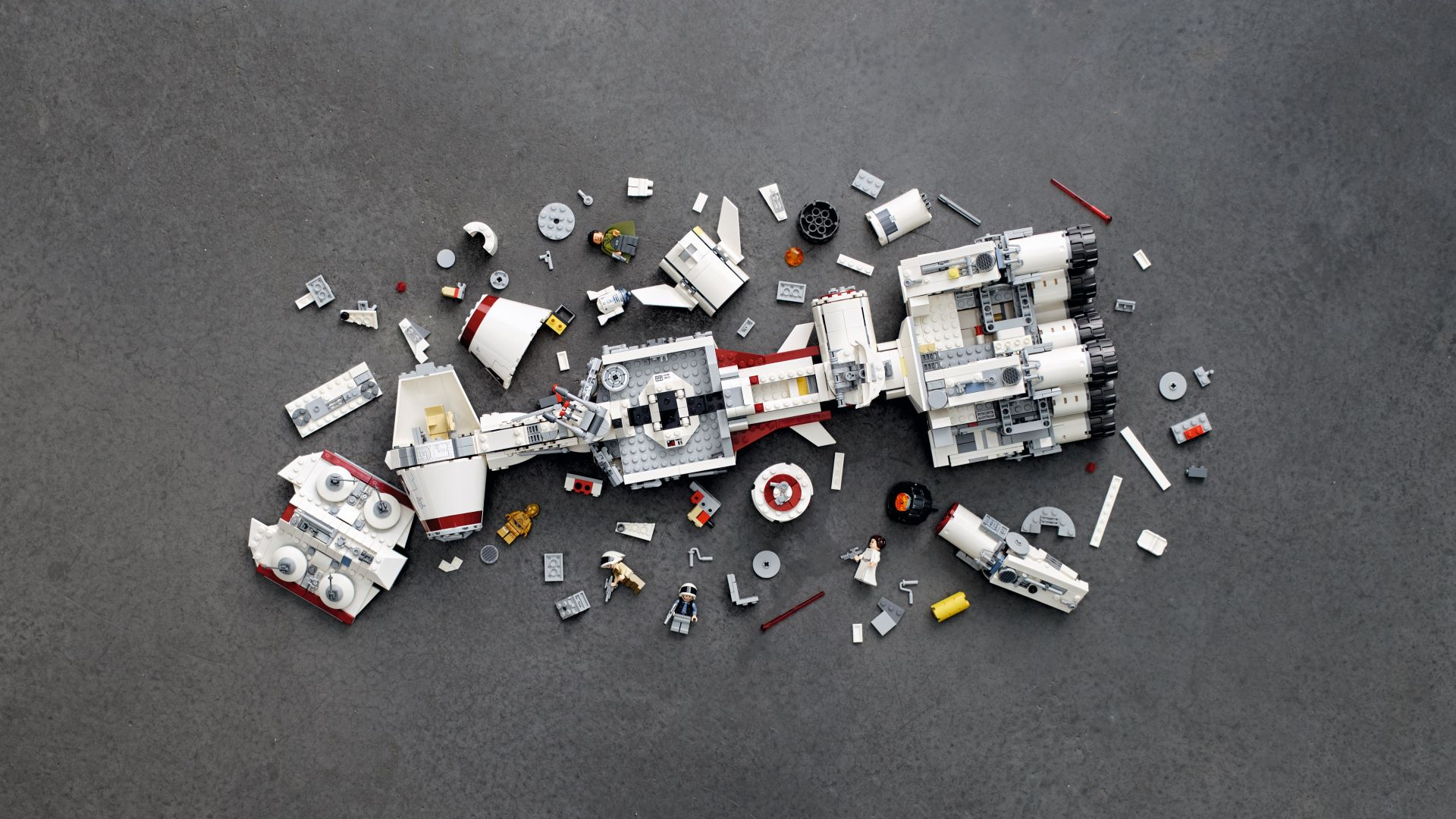

For 20 years, Jens Kronvold Frederiksen has been the resident Jedi Master in charge of Lego Star Wars. As Creative Director, he's overseen its transformation from a cool concept into a juggernaut of creativity and desire.
1999 was a year of contrasting fortunes for the two brands: The Phantom Menace was hitting theatres as Star Wars fever reached a peak; while Lego was in all kinds of business trouble, and there was reportedly a lot of internal debate about whether it should go ahead with the Star Wars tie-up at all.
Of course, the Star Wars line turned out to be one of the biggest sellers for Lego, and it was a cornerstone in the company's huge turnaround since then. (Our Lego tour guide says you can actually credit the Bionicle line with saving the company in its darkest hour, though.)
- There's a Lego Star Wars sale this weekend! Here's the best stuff in it
- See our picks of the other best Star Wars Lego you can buy right now
A Lego birdy tells us that when Jens interviewed for the Lego Star Wars Creative Director role, he hadn't seen any of the films. When the first interview went well, he had to get to bingeing the series ready for deeper discussions, though that was much easier when there were only three films…
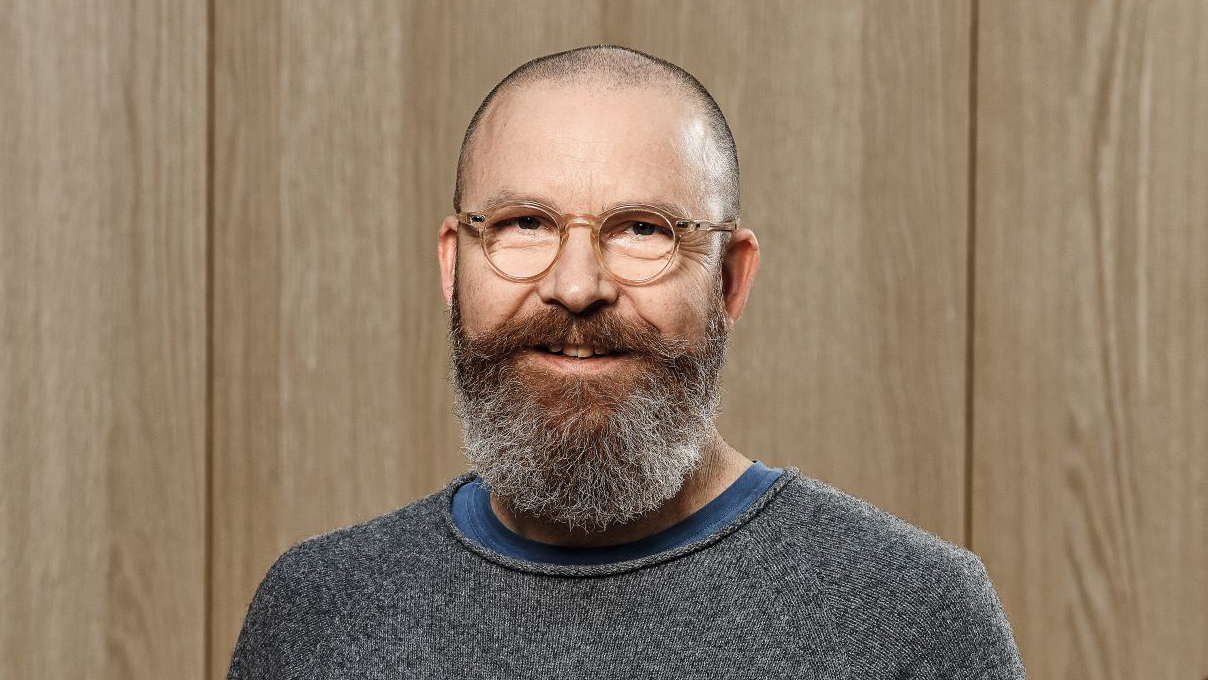
Jens Kronvold Frederiksen, Creative Director for Lego Star Wars.
Speaking to him now, it's clear that was the start of a deep love for the brand he shepherds. He talks about his work with a personal connection and affection that's no surprise given how much of his life he's been doing this. Like recalling years of memories with a family member, he can instantly summon stories that narrow to the smallest detail, while other parts of the time are lost among the thousands upon thousands of bricks he's put together over the years.
We meet in an exhibition in one of Lego's HQ buildings, locked away from the public. Jens' team of 10 designers have chosen their favourite models from the last 20 years, and these are displayed in a room designed to look like a Star Wars ship's bridge.
The first thing I ask, obviously, is which of the ships is his favourite from over the years. He walks us over to a pair of Millennium Falcons – the two versions of the giant, expensive Ultimate Collector Series models that have been released over the years.
Sign up to the T3 newsletter for smarter living straight to your inbox
Get all the latest news, reviews, deals and buying guides on gorgeous tech, home and active products from the T3 experts

Jens' original Ultimate Millenium Falcon from 2007 is on the left; the new version from 2017 is on the right. A decade of development makes a big difference.
The first version was one that he designed himself, and it started as a just a bit of fun – people online had complained that all the Falcons made so far couldn't fit four minifigures in the cockpit, like in the movies, so he started experimenting with what a model of that scale would look like.
When others saw what he was making, he was encouraged to just go wild with it, and to make the best Falcon he good, no matter the size or how many pieces. It was a kind of freedom, as he explains later, that only really came once. Since then, a new version of the Ultimate Collector Series Millennium Falcon has been released, which uses lots of new Lego parts that weren't available when building the original to hit a more faithful look (and to recreate the inside, which Jens didn't attempt with his version). But it's that first one that clearly holds the fondest memories.
T3: Do you have other favourites in this room?
Jens: I think the X-Wings are super-iconic, as well as the Millennium Falcon, so those two are probably some of the best when it comes to vehicle models.
[At this point, Jens walks us down a display that contains every X-Wing and TIE Fighter version over the years]

The display of TIE Fighter, X-Wing and Slave I models over the years.
There you have the latest version of the X-Wing, and if you compare with the one right from in the beginning, you can see the progress, and how design has changed over 20 years. Of course it’s a natural thing, but when we do something like that – a new edition of something we’ve done before – we always start all over from scratch.
There’s another model I’d also really like to mention. It’s very special to me. It’s the Death Star. We’ve had two versions of that product. I can’t remember when it was launched the first time, but it’s been available for many years now. And what I really like about that set is that it contains all the scenes – all the major scenes – from the Death Stars in the movies. So kids are really able to play out all the scenes there.
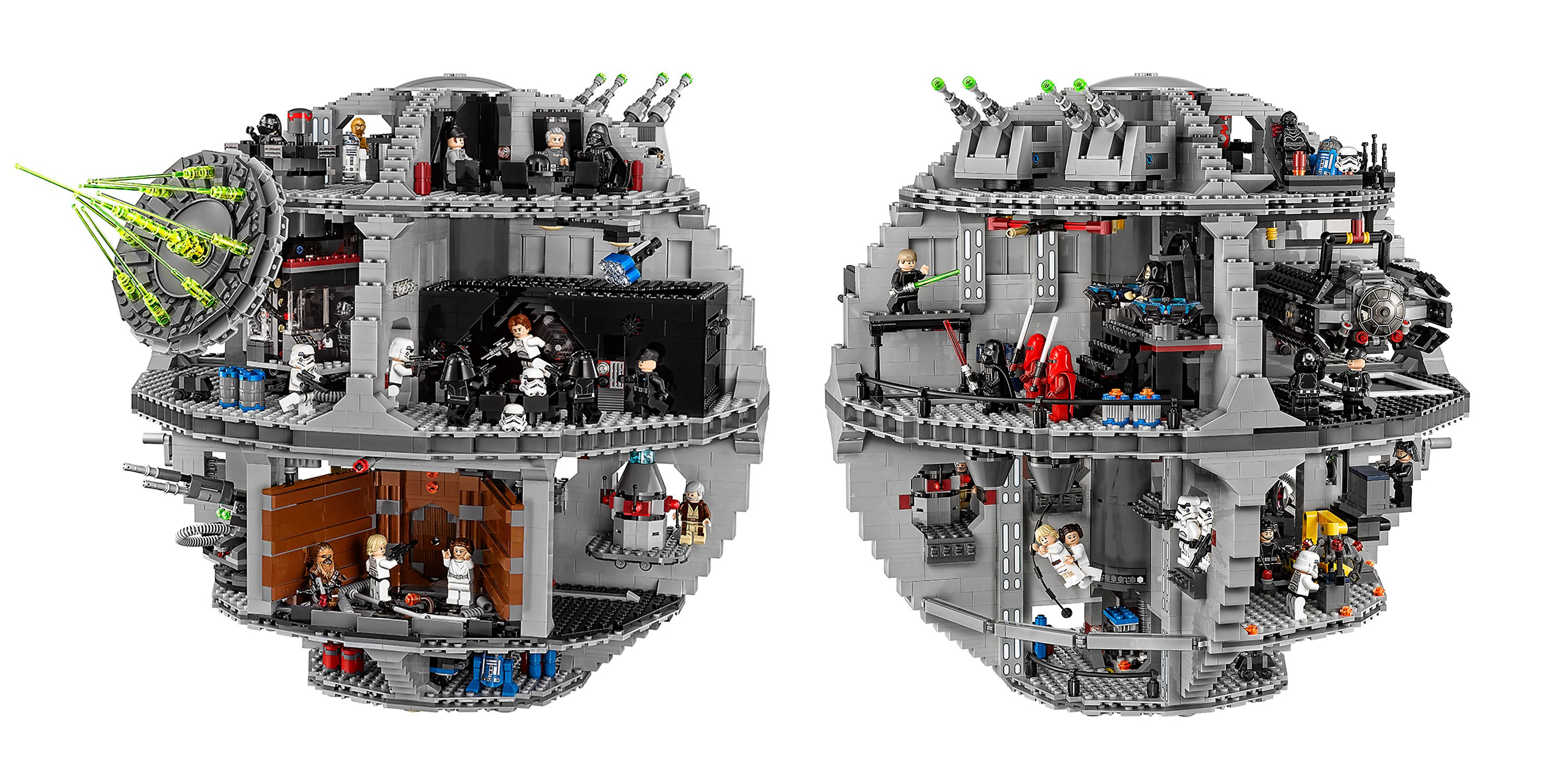
The Death Star, from front and back, which features a dozen scenes from the movies.
We know children build it. I think it’s marked 14+, but very often it’s something that’s on a kid’s wish list. The family put it together, which I think is great. And then after that, there are many, many hours of role-play in the product. So that thing about making something that can bring the family together is something I really like, specifically, about that product.
And then continuing with the products, I talked about ships and vehicles, but we also have what we’re calling play sets. It’s something we’ve done more and more of over the years, which are more like scenes from the movie. One example of that is Jabba’s Palace, here. So with these kind of sets, of course, what’s really important is the mini-figures, but also features and functions, so that they can play it out how it is in the movie.
This product actually was part of two sets. You have the palace, but also there’s a separate set called a Rancor Pit, when he’s being thrown down in the pit and is battling that monster. So the Palace set could be put on top of that, so suddenly you have a much bigger scene. But we wanted to split it up, partly because it would be a very expensive set if both pieces were together.
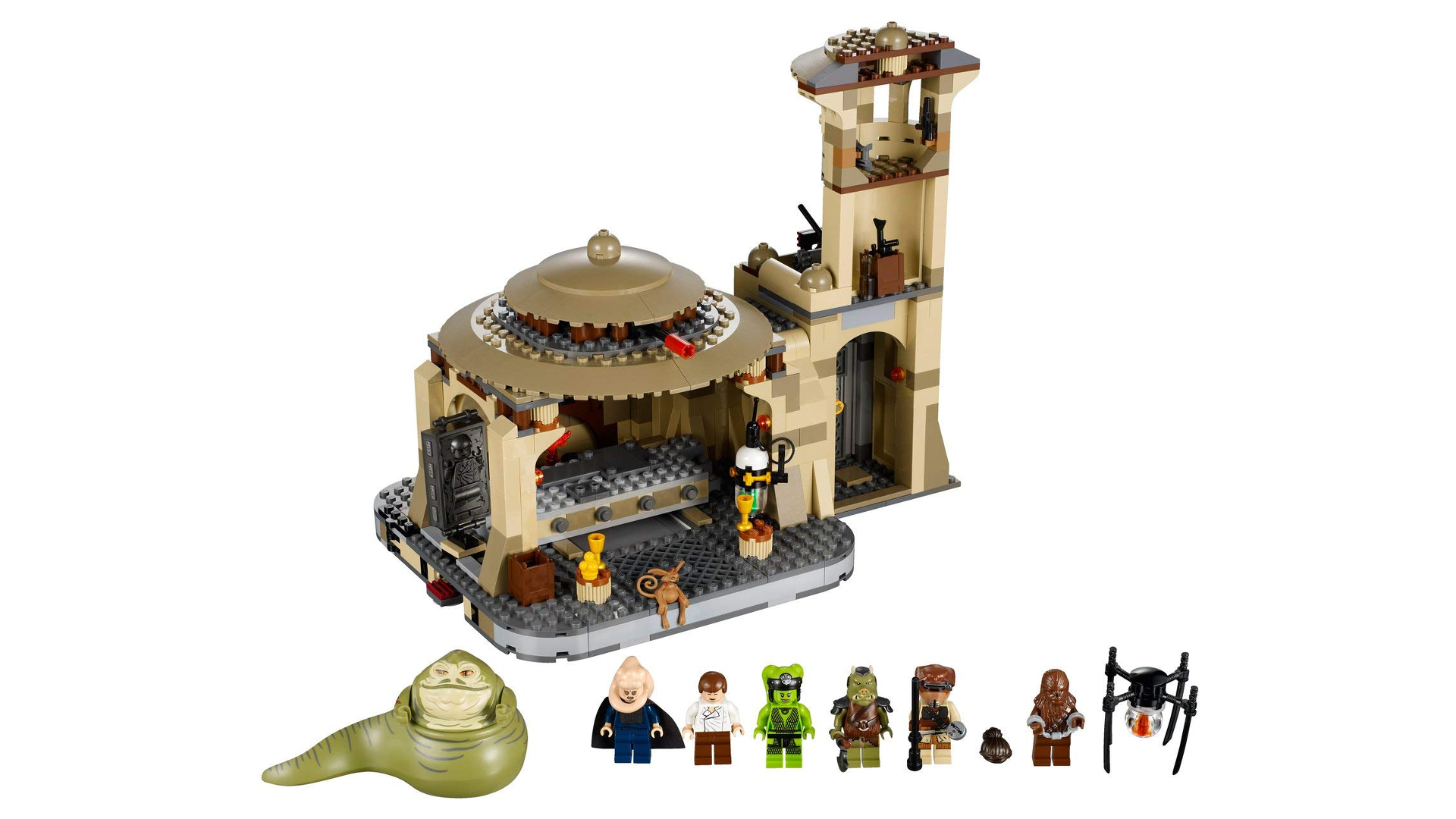
The Jabba's Palace set in question, which can fit on top of a matching Rancor Pit set.
When you’re creating at something like the Death Star, how do you decide exactly what you’re going to fit into the different scenes?
That was a long process. There were two designers that worked on the original one. The second version was more or less an upgrade. It wasn’t a major redesign. But I know the two designers that made the first one spent many, many hours watching the movies, and writing down all the different scenes that happen on the Death Star. And then we decided together which ones were the most important ones. We had the basic design of the model – we had already done a ‘sketch’ [Lego-speak for an early prototype] of that. And it was just about putting in these different scenes in different areas of the Death Star model where it made sense.
It was a long process. And again, also involved children along the way. In a case like that, we’re looking at whether the kids can handle the functions. Do they understand them? Do they make sense for the children? Are they fun? Things like that that are super-important for us.
I guess the fact that you’re almost making cartoonified versions of the scenes is also a factor. So do you go back and forth with Lucasfilm about how close they want it to be, or what you can cut out?
Of course, we are in close dialogue. But we have a very, very close relationship with Lucas and Disney. Actually, the contact that I have there, he’s been working there for 20 years. We had a 20-year anniversary, both of us. We’ve been working together for so many years now.
So they have a very strong understanding of what a Lego product is. And one thing that’s important is, of course, the humour. That’s part of what you were talking about. Because you could say, “Darth Vader – he’s the bad guy but he looks a little bit funny.” We’re totally aware of that. That’s where, again, the good relationship really shows, because sometimes we’re putting in small, funny features in the models that are not seen in the movie.
We are allowed to do that because it’s Lego. And we’re not showing it on the box front, but maybe there’s a little gimmick. One example: Admiral Ackbar, which is the Mon Calamari officer who's a super-serious guy. In our Lego product, he has a cup of coffee. Another one, and I can’t even remember if it came through, was in a Hoth scene. The designer, for some reason, had stuck a Popsicle to Leia’s hand. So she was in this snow landscape, eating a Popsicle. I can’t remember if it ended up being in the product, but it’s things like that.
So we are always trying to add these small, hidden things. And also, sometimes, more serious links to more nerdy content. It might be a thing that fans would know about – then we can put in small Easter eggs. The pilot in the Sandspeeder set is wearing the helmet Rey is holding in her hands in front of her home in The Force Awakens. And in general, on many elements with printed text in Aurebesh, the Star Wars alphabet, there are many small funny things written, such as designers’ names.
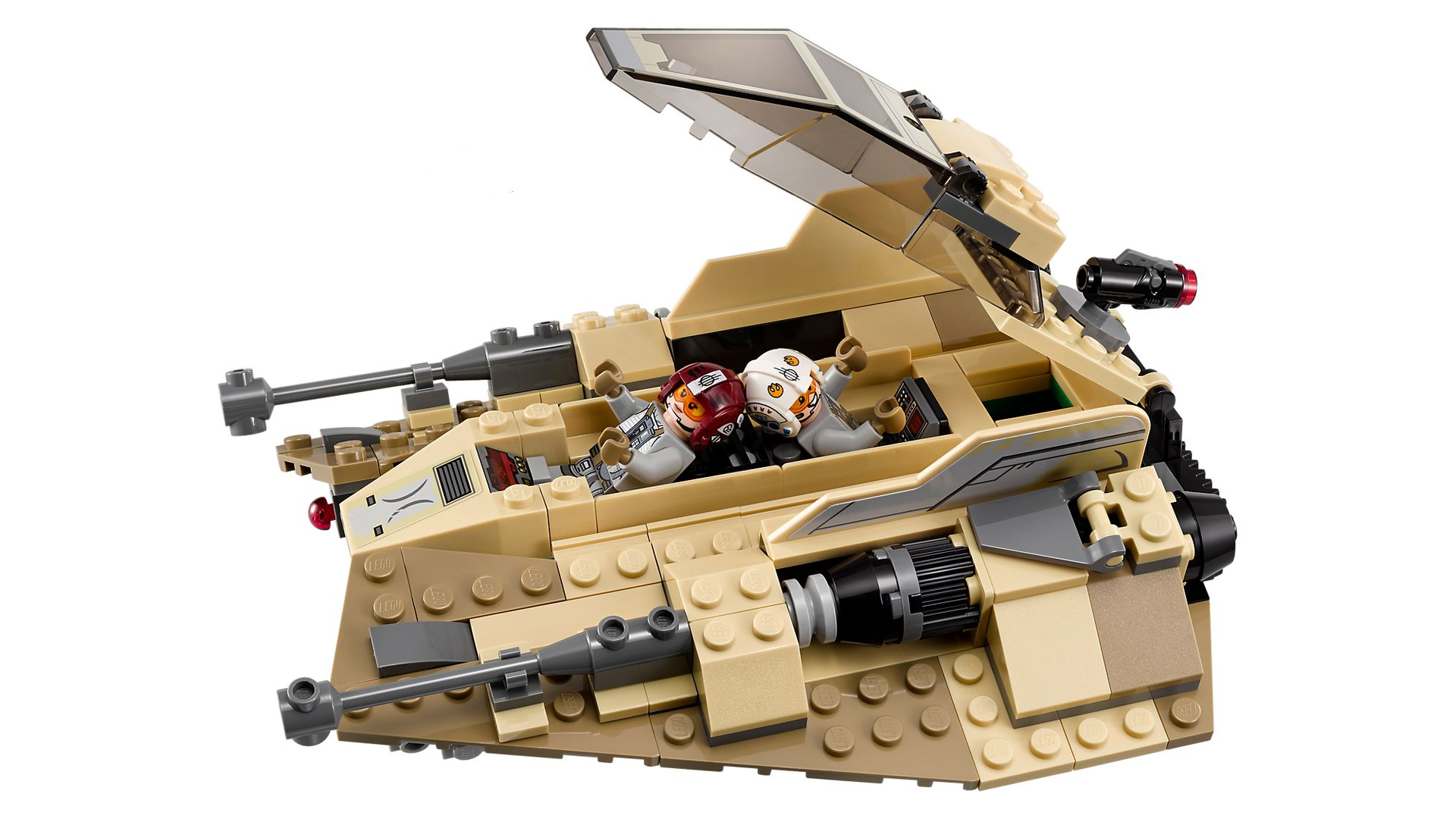
The Sandspeeder (and helmet) in question.
So you’ve been speaking with the same person at Disney for all your 20 years here. Has how your work with the Star Wars team changed much over that time? If you’re talking to the same person, do you still have a similar relationship as you did at the start?
Yeah, it’s the same team that we’re talking with, but it’s clear that things have changed over the years. Also, Lego Star Wars has become much bigger than it was in the previous years, and we know that we are a big part of the Star Wars brand in general. So yeah, it has changed. And then some years ago, Disney took over Lucasfilm. But it wasn’t really something that affected us much, because as I mentioned, it’s still the same people that we’re working with.
What’s the process of starting work on sets based on a new film that you don’t know anything about yet?
It’s a challenge, and the big challenge is that we’re starting out more than a year before it will end up on a shelf in stores. So it’s happening around the same time as the new movie is being made, which means they’re filming at the same time as we’re deciding and making products.
So we depend on getting references from the movie very early, and that can be a challenge sometimes. They’re absolutely doing their best, Lucas and Disney. Usually, we are supplied with concept art from very early stages. Normally, the first thing that happens is we’ll be taken through – very often by the director – the full story of the movie, so we can get a picture of what are the important things in the movie.
So then we get the reference. And based on that – or the concept art, most often – we try to put together an assortment. We are, of course, in close cooperation with Lucas and Disney, because they have more knowledge about the movie and what to focus on. And then when we have sketch models, we will put them in front of some kids, and see how they react. It’s an ongoing dialogue. They will very often change, including within in the movie itself, and so on.
And then the exciting part comes. Usually, when they start filming we are invited to visit the set often. So we’ll be in Pinewood Studios, seeing the sets and seeing the costumes, which is, of course, a very, very good inspiration for us. So that’s the process.
But it is, of course, more challenging, because if there are late changes to the movie, we’re almost ready for production with a product. And then it’s: “OK, can we change this?”
Like: “That scene’s not in it anymore”?
Well, we’ve had that as well. An example from The Force Awakens: there was a Snowspeeder in the movie, and we got a reference, and they made a full-sized prop of that vehicle. So we thought, “Well, it’s going to be quite important.”
And then suddenly it didn’t have that important role in the movie. It was actually just parked in the background. But fortunately, we could see in our kids’ testing that the kids really, really liked the vehicle, even not having it in any context – because they hadn’t seen the movie, of course, when they were playing with it – and they really liked it. And we couldn’t stop it at that time. It came out, and it was a really successful product anyway.
I guess there will be times when you see something that’s going to be in the movie, and you think, “We should definitely try to make this” but you realise you don’t have enough information to make it ready for launch. Do you delay it? Do you say, “Cancel it for now, and maybe we can come back to it later”?
Yeah, sometimes. And there are also cases where there are things that we really want to make as a product, but that we’re not allowed to make in our first launch that comes a few months before the movie’s out. Maybe it’s telling too much of the story, or something like that. So, most often, we’ll have a follow-up launch right after, where more products are being launched for that specific movie. And that’s when we come with the more secret stuff.
Is that part of the discussion with Disney? You’ll say, “We’d like to make these 10 models” and they say, “You can make those five on the first day, you can make those five later”?
Yeah. That’s a normal dialogue. I don’t know how it works on their end. I think Lucas and Disney are chatting with the movie story team or with the director of the movie, and they decide what can be made pre-movie and after.
When you do new models based on the older films, is that just driven by whatever you guys think will be fun to make? Or that works with the kids when you show it to them? Do you get any kind of push from Disney, or is it just where you think it’ll be fun to build?
Yeah, it’s another process. We make an assortment that consists of products related to a new movie or content, but we always also have some classic items. And that’s something that I think we’ll always have.
I guess you’re always going to have an X-Wing on sale.
Exactly. It’s like, as we call it, the Fire Station in Lego City. You know? It’s just something that needs to be available.
It never goes out of style.
Exactly. And there are some of the classics where it’s the same. So that’s also why there’s a long row of X-Wings [in the exhibition], because we are launching them regularly. Typically, we’ll have it worked out, and then we let it rest for a while, and then we’ll make a new version of it. But there are some that will almost always be available. And that’s something we decide. Again, everything is, of course, in cooperation with Lucasfilm. But the classic assortment is very often us. What fits into the portfolio? What did you have in last year’s assortment? And so on.
These sketch models that you kind of show to kids – how complete are they? How much detail do you try to put into them before you let people play with them?
Almost from the earliest draft. And we learn so much from these tests. First of all, if they understand the models. But also about stability. Does the model fall apart when they’re playing with it? Can they handle it? That’s information that’s really useful to have very early in the process. So it’s really, from a very early stage that the kids are involved.
So it needs to be in the early stage, but they also need to be quite close to what the designer is hoping the final version will be? It’s no good giving one to a kid and saying, “Oh, I’ll add some of the bits later” if it turns out those bits are going to fall off?
You’re right, but I’ll say you’ll probably be surprised if you saw a sketch, because in most cases there isn’t really, visually, a big difference from the earliest draft to the final one. What takes a long time in the design process is working around stability, for instance, and playability. That’s something where the designer builds the model over and over and over again to improve the structure. Another thing is also that the kids should be able to build it – it might be that the very first sketch model is a super-complex build that can’t be made by kids. But visually, it looks pretty close to how the final product would look like.
And then the designer can go back and say, “Can I build this any more simply?”
Yeah. But sometimes we’re getting big surprises when testing something. I remember one case, many years ago, when we were testing the Slave I. I did the model, so I can remember: we were lifting the model [from the front], and there was no problem. And then when we had the kids test it, a kid lifted it and pressed it, and the model totally disintegrated in the middle. It totally collapsed. And that’s because I have a bigger finger than a kid. So a kid is grabbing the model at a different place, and it couldn’t hold together. That’s why the kids tests are super-important, because they’re handling and playing with the models in a very different way than we are expecting.
The difference in detail between the original X-Wing and the latest one is big, and obviously that needs a lot more pieces. How do you find the balance between the right kind of cost that you think people will want to buy it for, and how much detail you’d like to put in? I’m guessing you could just add bricks forever, and add more details forever?
That’s one of the big challenges for the designers, of course, and it’s also where their skills are really being tested. Because usually, they’re being briefed that this new model’s going to be $79.99 or whatever. That’s in the brief, so that means that there’s the limit of how many pieces you can put in it. Because you’re right: you can continue adding pieces, and make a product that cannot be afforded by anybody. And that’s not what we want. We want to have the right level of detail, but also the right price for the product. So it is a balance.
How do they know what to aim for? If you know that you’re aiming for $80, does the designer then know, “OK, I have around 600 pieces to play with” – is it that kind of thing?
Yeah, the experienced designers will have a good idea about how many pieces they can put into a set. And also, we want to ensure for the consumer that the value they get is similar to another set at the same price. So we have a good idea about approximately how many pieces you can get.
And then with something like the Ultimate Collector Series, do you just kind of go, “Well, let’s see how many pieces it is, and we’ll price it”?
Actually, that was just the case with the first one I did. That was the craziest thing. It only happened that one time. It was just like, “No, just built the ultimate one, and it’ll be for the Ultimate Collector. Just build the best ever. And then we can price it afterwards, and we’ll figure out what it should cost.”
You can kind of say, “Don’t worry about it. It’s a minifigure-scale Millennium Falcon. People will buy it.”
Yeah. But at that time, we didn’t know, because we’d never tried it. I can’t remember what the retail price was, but it was an expensive set. So we had no idea if it would work or not. But it did. And that’s why we’ve done several of these sets.
So it inspired the range?
I would say so. And how high can you take it? How big a set can we make?
With something like the Super Star Destroyer – which I remember was, for a time, your ultimate “put it on the shelf and show it off” model on sale – is it just a case of your team going, “Listen, you know what would be really cool? Just a massive, massive Star Destroyer”?
Yeah. Along those lines, we are following fan forums very, very closely – both getting their feedback and input, but they’re also a huge inspiration for us on incoming products. So we’re listening to what they wish for, and doing our best to make it.
Is there a set that you haven’t been able to make yet, that you would like to?
Yes, there are several. And that, again, is for different reasons. There are some that would be very difficult to make a play model, both because they would be too fragile, or are maybe not appealing to kids. And then of course there’s the Ultimate Collector Series opportunity. There are models that are super-difficult to create, though. One example is, for instance, the medical frigate [Star Wars fans know this as the Nebulon B, from the end of The Empire Strikes Back]. We know that that specific ship has been a high request from fans, and there are a lot of fan creations out there of that ship. But it’s one where we’ve been doing some experiments and looked into it as a potential one, but we haven’t really solved the stability issue.
It’s got a very thin body.
Yeah, and it’s standing on this very high structure. And for us, it’s important that also, when we’re doing these big display models, that they’re not too fragile. If we haven’t got a solution for how we can solve this so that we can improve the stability, or so that we believe it’s the right quality, then we’re not going to make it. I’m not going to say a medical frigate will never happen, but of course, we need to make sure that the quality is the level it should be. Some of these fan creations are extremely beautiful, but we have some pretty high quality standards for products we actually sell.
I guess you’ve got maybe a desk somewhere that’s full of models that just didn’t quite work for one reason or another?
We have a lot of sketches. Sometimes we try them, and it could also be, in the meantime, that we’ve got some new elements that solve a specific problem we had when creating the first model or so. That’s happening quite often as well.
Can you think of one that you couldn’t make originally that you were then able to make because of something that changed?
Slave I, again, where the first versions were very brick-like. The only angled pieces we had were roof tiles, and later – well, it’s many years ago now – we got our shaped elements, which are more organic, and made us capable of making a more accurate model. And also, for newer models, we actually created a new piece. If you look at the dark green rounded area on the side, you can see how it was looking on the previous model. We made these. It’s like a quarter of a donut, almost. If you put two of them together, you can make a much better curve.
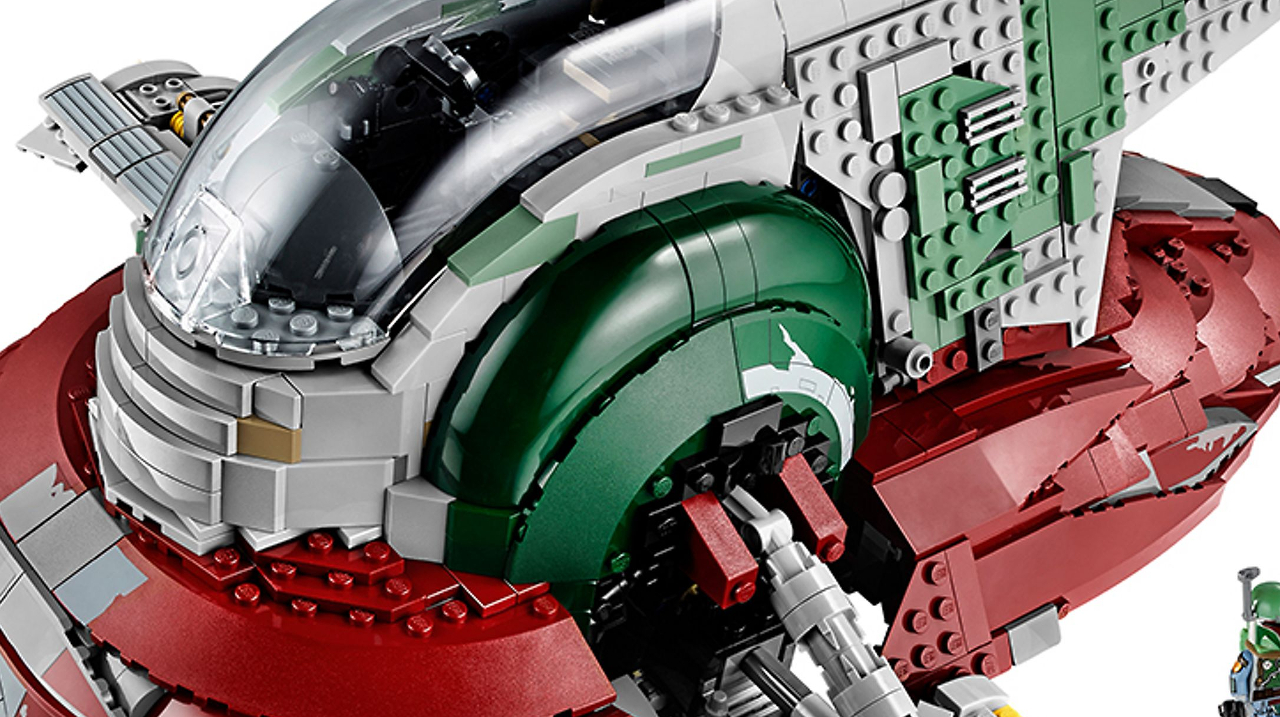
Round bits! Suitable for giant Lego doughnuts, or all your other round-corner needs.
And that was made for Slave I, for the first time?
That was made for there. But again, when we are creating these new pieces, we always try to make things from existing pieces, also to show the versatility of Lego. You can use what you have in your bin, and you can create anything. So we’re trying to avoid making too many special pieces for our models. When creating a new piece like this, we’re also trading and talking to other designers, saying: “Hey, is this something you could use in a City model or something else?” So we try to make the elements as generic as possible. Also, it’s so that when that piece ends up in a bin, it’s not something that’s like, “Hey, what is that?” It’s actually a piece that could inspire something for the kid. Maybe even a big donut.
It could be the base of a statue that they’ve made or something like that.
And that’s really the beauty of it. When the elements are created the right way, they can be useful for other things. When we’re designing it, we’re always saying that we’re not looking at the elements for what they’ve intended for – we’re looking at them as shapes.
So it means that we have a huge wall where we have all the elements there. And there could be, let’s say, a pink flowerpot sitting there that’s been used in one of the fringe models. But it looks exactly like the exhaust, and that specific style. Then we’ll just make it in a new colour, and add that element, and it’s showing the versatility again of the element. So that’s how it works.
Is the Millennium Falcon your favourite ship overall? Is that why you were keen to make a big version of it? Or do you have a different favourite ship?
I like a lot of the villain ships. I like the TIE Fighters. I like the Star Destroyers, and so on. But I think the Millennium Falcon is the icon of Star Wars for most people, and it is the same for me.
Is there ever any consideration of making ships that are from the wider media, from comics or from cartoons or anything?
Yeah, and we have done it a couple of times over the years.
There’s some Clone Wars stuff.
Yeah, but Clone Wars has been a big thing. We did a lot of Clone Wars things back in the day when the TV series was on.
Many years ago, we made a set that was called TIE Fighters Collection, and it contained four TIE Fighters. There was Darth Vader’s TIE Fighter. There were two from the movies, and then there was one called Droid TIE Fighter. That’s a ship that’s never been seen anywhere. It’s been mentioned in what they call the Expanded Universe, so it might have been in a novel or a comic or something like that. Honestly, I just saw it in a book, and I thought it was super, super cool. And then we made it as a product. So I don’t know where it has been used previously. So we have done things like that, and we’ve also done things that have been from console games and so on.
I remember a very creative one called the the TIE Crawler. I don’t know where it comes from – it was also in a book. Imagine a TIE Fighter where around the wings they are like tank tracks, like a WW1 Mk4 tank. So it could drive on these tracks. Anyway, that made it far as well, many years ago. So we have been exploring a lot of things. We also will in future, that’s for sure.
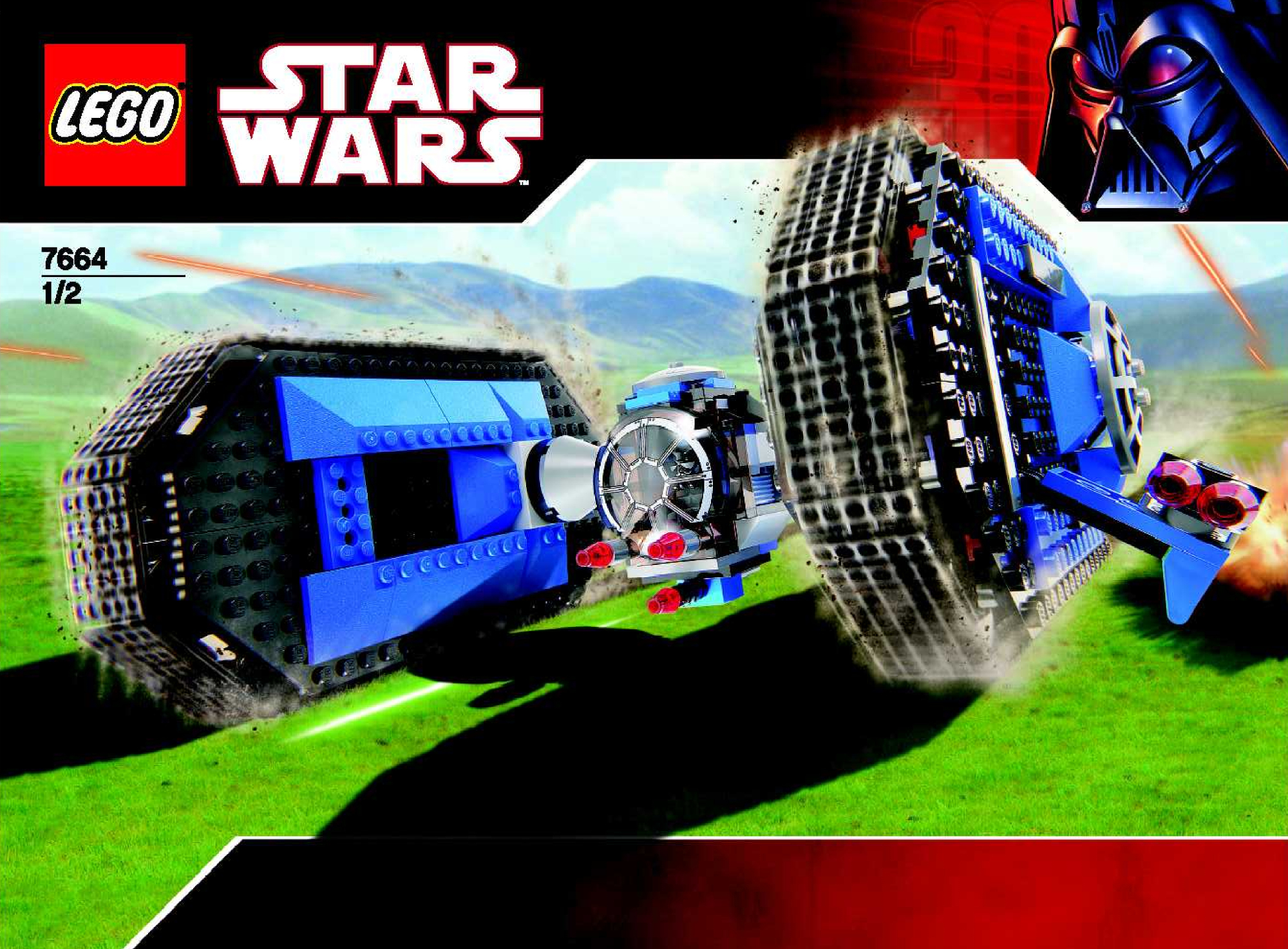
Not much evidence of the TIE Crawler exists on Lego's site these days, but the building instructions are available to download there if you want to try to recreate it!
Do you still get to design much these days?
Unfortunately not, but I’m, of course, a big part of it, and I love to build the models. I build them in the process. And then when the products are done, I build everything that the designers are doing. So I build all the models.
So you do a final check?
Exactly. That’s both as a check, but also… I love to build. And I think it’s also that I want the products to be consistent, if you know what I mean? It’s okay if the Star Wars Lego fans can tell, “Oh, it might be that designer who built this model” but it shouldn’t be too clear. I want it to be consistent. Of course, the quality is high, because it goes through so many internal checks.
But also, along with the design style, for me, it’s super-important with Star Wars that it’s very, very clear that it’s Lego. It means that maybe we’re creating a model that could easily cover up the knobs on the back, but I want there to always be visible Lego knobs on the model to a certain degree, so that it’s easy to tell that it’s a Lego model.
It’s similar to how we’re using as many of the regular Lego system elements as possible. We are using Technic elements, but very often the functionality is hidden inside to strengthen the model. It should clearly look like a classic Lego model.
I think in some ways, making sure that people can tell it’s Lego almost shows what a good job you’ve done to make it look as close to the original version as it does, because it’s hard to put a load of bricks together and to produce a rounded spaceship. It adds emphasis – it looks this good, and you’re not even hiding the studs.
Fortunately, there are really, really talented designers in the team, and they are very good at getting that balance right. Because as you say, you should be able to tell it’s a Lego model, but of course, we want to make it as accurate as absolutely possible. But there are also some things that conflict with the design. First of all, we want to make a good toy. So it means that if we have a completely grey or white vehicle in Star Wars, it wouldn’t be all white or all grey as a Lego model. There would be different shades. There would be black, there would be dark red, there would be a few white or sand-colour pieces, and so on. That’s simply because we want it to be a good building experience. If you open a box full of white pieces, it’s a nightmare. You’ll spend all your time searching for that specific piece.
So we’re really, really thinking about it when we’re putting them all together – that the search time shouldn’t be too long. So when you search for a specific element, it shouldn’t take too long a time.
Of course, now you put things in numbered bags.
Yes, for helping the building process. So that’s really something. But it also means that we could make a super-accurate, totally white model. But I wouldn’t even call all that a limitation. It’s just part of it.
Although I guess in Lego Creator Expert models, that are all about the accuracy, you can go, “Oh, that’s fine. This is all white, and that’s okay”.
Yeah. And the same thing is true with our big sets, like the Millennium Falcon. Well, and when we’re packing specific bags with elements, again we’re trying to make it as smart as possible and reduce the 'search time', as we call it. But that is about accuracy. So of course, it should have the right colours.
But you will also see inside of a model that there is a whole rainbow of colours. It’s hidden. And that, again, is to make it a good building experience. And also, if you put a grey piece on top of a grey piece, it can be really, really hard to tell exactly how it’s fitting. Maybe it’s a small piece that you have to put on something, but if that little piece is red, it’s easy to see: “That’s where it goes.” So that’s part of it.
This interview has been lightly edited for clarity.
Matt is T3's former AV and Smart Home Editor (UK), master of all things audiovisual, overseeing our TV, speakers and headphones coverage. He also covered smart home products and large appliances, as well as our toys and games articles. He's can explain both what Dolby Vision IQ is and why the Lego you're building doesn't fit together the way the instructions say, so is truly invaluable. Matt has worked for tech publications for over 10 years, in print and online, including running T3's print magazine and launching its most recent redesign. He's also contributed to a huge number of tech and gaming titles over the years. Say hello if you see him roaming the halls at CES, IFA or Toy Fair. Matt now works for our sister title TechRadar.
-
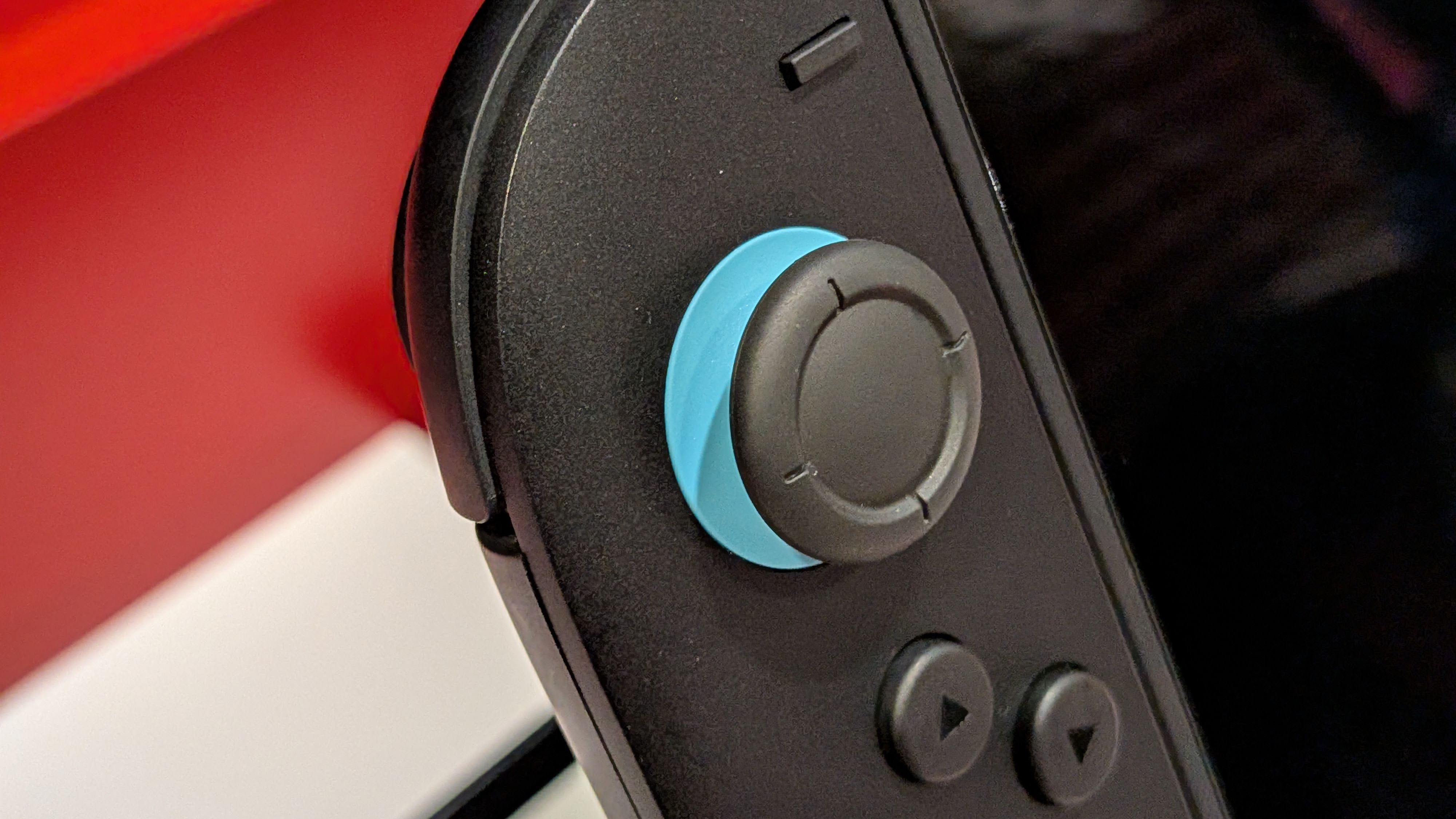 Nintendo Switch 2 tariff woes continue – here's how much it could cost you
Nintendo Switch 2 tariff woes continue – here's how much it could cost youExperts claim the Switch 2 will continue to be affected by Trump's tariffs – even as much as 145%
By Rik Henderson
-
 This one-day Apple Watch challenge could earn you a secret (non-virtual) reward
This one-day Apple Watch challenge could earn you a secret (non-virtual) rewardApple is now handing out animated trophies and real-life pins if you do a bit of exercise
By Matt Kollat